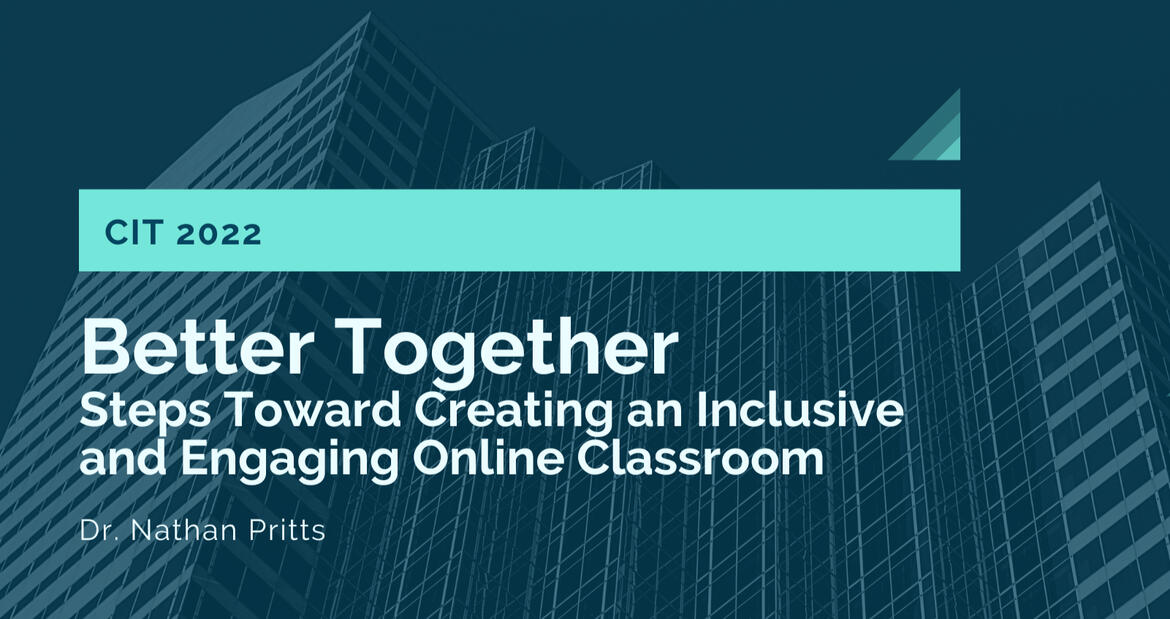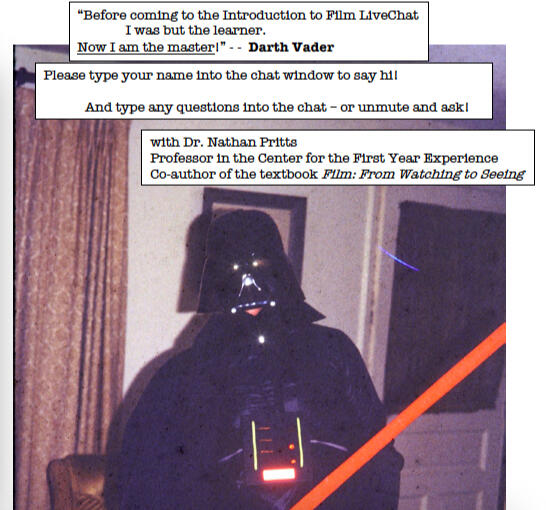Teaching well takes humanity.Teaching well online takes radical humanity.
Building a handbook of the strategies and best practices essential for designing and delivering meaningful learning experiences to students online... one chapter at a time.
Table of Contents
...in progress...new chapters being added...00 / Toward a More Radical Humanity (A Preface)Teaching requires compassion and empathy. Humanity. But teaching online requires radical humanity. {coming soon}
Section 1 / Teaching Mindfully
You're a master of course content and you know how to spark students from beginner to mastery level. But how do you design a meaningful learning experience within the architecture of the online classroom?>Using Announcements to Give Narrative Shape to Your Online CourseHow can instructors develop and implement a comprehensive communication strategy—something separate from content and grounded in pedagogy? >>>How to Get the Most Out of Online DiscussionsThe discussion board can be a meaningful location for active learning, but what are the best ways to ensure this best case scenario happens? >>>Failure to Launch? – Strategies for Success in the First Week of Online ClassesThe first week of an online class is crucial for establishing expectations and a framework for success. So what steps can we take to make that happens? >>>Three Things to Consider Before You Kick Off Synchronous Office Hours in Online ClassesWhile the online classroom provides a variety of robust and structured ways for engagement between students and instructors, how can instructors supercharge the concept of office hours for a new modality? >>>Three Questions Students Ask - And the Answers They Really Need!It's important to realize that the answers instructors give to students might not be the answers they really need!{coming soon}
Section 2 / Optimize for Empathy
*You've designed a dynamic learning environment, packed with provocative content and opportunities for deep insight. But how can you support the student learners in your class as real people and not just pixels? And how can you make that learning, that support, come alive so that students engage?>Engaging Students by Sharing Your Personal NarrativeShouldn’t your introduction material talk about more than the weather outside your window, whatever antics your cat is getting up to, and your list of titles, degrees, and accolades - and find a way to build a bridge between your experiences and theirs? >>>Meet Me Where I Am: Announcements and Discussions for Learner Context{coming soon}>Creating a Feedback Culture in Online CoursesFeedback needs to be constructed with mindful intention – but how can we ensure it lands with students? >>>Collaborative Annotations for Active Reading, Retention, and Engagement!Active reading is the key to ensuring we grasp the information in a text and experience the rich pleasures that come from reading. But how can we partner with students to bring this process to life?>>>Lighting the Path: Connections Between Classes and CareersHow can we ensure that students see the connections between general education classes and future academic and career success? >>>A Quickstart Guide to Planning and Recording Audio LecturesThere are benefits to embedding your voice throughout your class for student learning and engagement - but what's possible when you really lean into the strengths of the medium? >>
**00 / How To Level Up **I can’t imagine the kinds of innovation that are possible when we stop thinking with our fingers. I can’t imagine what I can’t yet imagine… but I can imagine a plan that helps me get there. And this is it. >>

CIT 2022Download a copy of my slides >>
Engaging with students is crucial to ensuring the learning lands. But engaging online requires us to step out from behind the podium, and to create a presence that’s about more than just course content. And while there are several ways an instructor can make the online course content and activities come to life for students, there’s a larger framework that needs to be put in place. By making yourself real, vulnerable, and present in the online classroom, you can demonstrate that your classroom is a safe space, one that students are enthusiastic to participate in. And by creating a diverse dialogic experience – asking questions and bringing in other voices to help solidify your teaching – you’ll create a more inclusive and engaging online classroom.
Collaborative Annotations for Active Reading, Retention, and Engagement!

Read a bit about dynamic annotations in The UAGC Chronicle >>
Read the full article at The Teaching Professor >>
We don’t often think about the process of reading. We just do it. We point our eyes in the direction of some symbols and let our minds decode and process them. It’s an autopilot function.But there are ways to bring mindfulness and a new intention to the process – ways to unlock profound levels of engagement.
Active reading is the key to ensuring we grasp the information in a text
and experience all the rich pleasures that come from reading. Active readers aim to interpret rather than gain a basic understanding of the text.Active reading enables the reader to understand the material. It equips the reader with the skills needed to analyze what you’ve read and respond critically, whether in a writing assignment, an exam or on job tasks.
How To Run Your Classroom - so it doesn't run you!
TLC 2020Download a copy of my slides >>Watch the webinar >>
How are we – how are any of us – supposed to find the time to do any of this stuff? The best practice stuff. The advanced / expert / mastery level up stuff. It’s all we can manage to teach mindfully in the online modality. So how can we also be expected to find the time necessary to optimize the learning experience, to both iterate and innovate within the online classroom?But once we reimagine the cycle of incremental progress that fuels the online classroom, once we manage and deploy our thinking on larger ideas about our online teaching, we can open a window. And this window shows us a wider scope of iteration and innovation in our teaching, and in the classroom itself.Read "How to Level Up" on the TLC Thought Leaders blog >>I can’t imagine the kinds of innovation that are possible when we stop thinking with our fingers. I can’t imagine what I can’t yet imagine… but I can imagine a plan that helps me get there.And this is it.
Failure to Launch – Strategies for Success in the First Week of Online Classes

Watch my presentation from ADEIL 2020 >>Download a copy of my slides >>Read the article in The Toolbox | Vol. 20, No. 1 from the National Resource Center for The First-Year Experience and Students in Transition >>
The first week of an online class is crucial for establishing the landscape, the procedure and the tone. With a few clicks, after only a few hours of inhabiting their new course shell, students are going to draw conclusions about the scope of the academic content they’ll be mastering, how their new class functions, and about their new teacher, too. That’s a lot of pressure on instructors to shape the experience of that first week in such a way that provides context for the learning, presents it as easily accessible, and generally ensures that students feel well supported.
***Download the Starting Gate Tracker template >> ***
Whatever the situation, it’s clear that the first week of an online class is an important one. Fortunately, the online modality provides instructors with many opportunities to connect with their students – to welcome them to class, to reach out to them both as a newly founded community of learners as well as on a more personal level, and to smooth over pain points that might be a barrier to success… to ensure that students feel present and grounded, that they know they have support.
One Model for Building a Video Library for First-Year Student Support

Nathan Pritts, PhD + Jennifer Vogel, PhD
Annual Conference on the First-Year Experience
2/18 @ 1:45 et
Download a copy of the deck >>OLC Innovate 2021
View the VoiceThread presentation >>
Everyone knows that video can be a powerful tool for engagement and instruction in online classes. But what might a comprehensive strategy look like – one that encompasses all the classes in a university first-year sequence, one that aims to develop an intentional roster of student-facing video content, and one that is designed to support student success while providing an additional tool for adjunct faculty and advising partners?
Download the Classroom Walkthrough Video Talking Points Outline >>Download the Tips + FAQ sheet >>
In this presentation, we’ll describe the genesis of the project and walk you through the development – including our roll-out plan to generate faculty consensus and buy-in, the on-boarding content-creation materials, the conceptual framework for the videos themselves, and the production cycle all leading to the launch of our YouTube page. We’ll also share some of the (always changing!) analytics data we gathered, discuss how we got the word out to other stakeholders within the University, and to students, and we’ll conclude by pointing the way forward with practical tips and lessons learned along the way.
Visit the UAGC Center for Enhancement of First-Year Experience YouTube channel >>*Watch, Like, Subscribe! *
Lighting the Path: Making Connections Between Classes and Careers

OLC Innovate 2020
Answering Why: Strategies for Motivating Student Learning in Non-Major ClassesDownload a copy of my slides >>
Students can have a hard time seeing how general education requirements and foundational classes help them achieve their goals. Students, especially adult learners, want to make measurable progress toward their degrees right out of the gate. Actually, want might be too weak a word. As they balance jobs, families, an income gap, and student debt that grows weekly, they need to make progress as a tangible achievement to keep them going.
Watch a presentation of an early version of this for the 2019 TLC Conference >>
But how do we put the imprint of this journey on individual classes? We can do this in part by creating a context for the learning in our courses and through instilling a sense of direction by infusing reflection in the classroom. It’s our job to show students the connections and lay bare the mechanism.Read the article at Faculty Focus >>
A Quickstart Guide to Planning and Recording Audio Lectures

Watch the presentation at Get CenterED 2020 >>When I decided to record audio instructional content for my online classes, I didn't just read my classroom lectures into a mic. Instead, I took a deep dive into the world of podcasting and transformed my weekly lectures, leaning into the strengths of the medium, adding new elements, and making them easily accessible so students can take them wherever they want, and listen however they choose - disrupting the LMS and bringing the classroom to life anywhere!Read the article at The Scholarly Teacher >>
I want to demystify the process, and help other faculty learn from my mistakes. When I began this, I figured I’d just flip my mic on and start talking. What I learned through a month of research, preparation, and recording showed me that while recording audio lectures isn’t difficult, it isn’t as straightforward as I imagined either.
Creating a Feedback Culture in Online Courses

One of the most powerful tools educators online can use to help students succeed is feedback. Feedback can take a range of forms, can be delivered through a variety of methods, and can be lodged in an array of locations throughout the course shell. But, at a basic level, and whether you’ve integrated feedback into a nuanced cycle of scaffolded activities or are just sitting down to grade this week’s raft of discussion boards, feedback presents an opportunity to communicate with your students.
TCC 2021
Breaking Past the Wall of Noise – Feedback that Truly FeedsDownload a copy of my slides >>
Feedback needs to be constructed with mindful intention – right alongside your lectures and videos, hand in hand with your instructional materials and any synchronous class time. To do that, there are things we need to understand to ensure that the feedback a student receives matches the feedback we give, and there are some simple tips we can put into place to ensure that students understand how to process and act upon that feedback to help put them in a position to succeed – in class, and going forward on their academic and professional journey.
Using Announcements to Give Narrative Shape to Your Online Course

In order to ensure that students know where to center their attention when they “click” into the classroom, we need to tell them. We need to craft a narrative for our classes, one that hinges on content but connects with our students. And while instructors may feel as if they need to overload every interaction with course content, the online classroom requires instructors to develop and implement a comprehensive communication strategy—something separate from content and grounded in pedagogy. The announcement feature is one tool that many learning management systems allow the instructor to operationalize for this purpose.
***Download some sample announcements >> ***
The announcement functionality in your online class can be more than just a greeting, or a way to wrangle a list of due dates. Students need to understand the narrative of your course and announcements are one of the most important tools instructors have to craft that story. By creating a roadmap—not only to your course but to a larger idea of academic and personal success—announcements in your online classes can support students in their day-to-day work while preparing them for a brighter and more fulfilling tomorrow.Read the article at Faculty Focus >>
Three Things to Consider Before You Kick Off Synchronous Office Hours in Online Classes

When I first made the switch from traditional face-to-face teaching in higher education to teaching in the online modality (almost 15 years ago!), I was obsessed with finding ways to maintain the classroom experience I was used to. But as the weeks, months, and years went by, instead of thinking I had lost something in the transition, I leaned into the inherent strengths of the online classroom—those things that couldn’t be replicated in a F2F classroom.It’s not so much about translating strategies from one modality to the other, as it is about developing and learning entirely new ways to do things—methods that are rooted in the modality itself.
Read the article at eLearn Magazine >>What follows is just a few thoughts on a subject—maybe a push or a nudge if you're thinking about taking the same leap. Sharing what I've done, now that I've done it, might serve to demystify the process for people who, like me, want to try running synchronous office hours in their online classes.
The Project
Radical Humanity: Teaching & Learning Online is a dynamic handbook, built one chapter at a time, covering the strategies and best practices essential to designing and delivering meaningful learning experiences for students online.Once completed, the source content of the text will remain online free to use. A revised and expanded edition, with exclusive content, will be available in print.